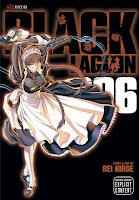Anyone who follows this blog will notice that I'm consistently behind the curve when it comes to reviewing new comic book material. I make no apologies for that. This is strictly an amateur effort written from the other side of the world. But I have let July and much of June slip by, so I need to get back into the habit of writing reviews again. It's really more for maintaining my sanity than anything else.
I thought I'd start with some manga since it's been awhile since I've actually read any, and picked Rei Hiroe's fan-favorite series Black Lagoon. Now, Black Lagoon easily stood out when it first popped-up in English translation in 2008. Aimed at a burgeoning market for young adults, it wasn't some shonen fight manga where the preternaturally gifted hero trains hard while spouting platitudes about peace, harmony, and that the only thing worth fighting for is to protect your loved ones. Nor was it some cutesy seinen title exploiting the moe angle. What Black Lagoon delivered was straight-up, testosterone-fueled, foul mouthed, hard drinking, gun-toting, John Woo styled action and mayhem. Definitely not for preteens, but perfect fantasy material for people who hate their jobs: Volume 1 is about a mild-mannered, Japanese salaryman named Rokuro "Rock" Okajima who quits his job to join the very band of American pirates who kidnapped him after he realizes that the corporation he loyally served was all too willing to sell him down the river. These pirates, known collectively as the Lagoon Traders, operate out of the fictional Thai city of Roanapur - your basic Southeast Asian den of iniquity populated by every conceivable lowlife from Chinese triads to the Russian mafia, each with their own representative badass for when things become inevitably hairy. This is a dude's idea of entertainment. But in true otaku fashion, most of the toughest badasses happen to fulfill some fanboy quotient. There's the Lagoon Trader's resident gunslinger Revy "Two Hands", a nihilistic Chinese-American assassin who wears tight tank-tops and even tighter cut-off shorts. The highlight of volume 1 was seeing her go toe-to-toe with Roberta, an ex-FARC guerilla who mops the floor with everyone while wearing thick eyeglasses and dressed in a maid's uniform. Similarly fetishistic characters are introduced in succeeding volumes along with the usual action movie types. In case this misleads unfamiliar readers, Black Lagoon is grounded in a facsimile of the real world, not in an alternate timeline populated with more fantastic elements. Its more ludicrous features operate within the parameters of the action movie genre.
Volume 6 marks the return of Roberta to Roanapur, after her exit in volume 1. But before we get to her, the book starts of with a story of the Lagoon Traders becoming embroiled with a counterfeiter on the run from her displeased clients. There's some high-tech skullduggery about the counterfeiting operation that complicates the plot. But it's not particularly well-explained before the guns are quickly bought out. The action first takes place in a church run by weapons-smuggling nuns; then to hotel rooms; a collapsing warehouse; and finally to the Lagoon Trader's own torpedo boat the Black Lagoon. Aside from the nuns carrying assault rifles, the scheme somehow manages to involve a motley assortment of characters including a cowboy from Florida (?), a recurring knife-throwing Chinese killer, a sadistic pyro, an androgynous pretty boy gunman, and a chainsaw wielding gothic lolita. It's all pretty mindless, fun, entertainment. And somehow it all gets resolved with judicious computer hacking.
The assassination of Roberta's wealthy patron prompts her to come back to Roanapur. This makes the local criminal warlords go into a tizzy, remembering how much collateral damage she caused last time. But before anyone can suss out her exact motivations, another maid also possessing deadly skills shows up and begins to tear up the place. It's at this point that the volume ends.
Rei Hiroe inculcates this volume of Black Lagoon with the usual frenetic energy and extreme action. But the book also showcases many of his weaknesses. His staging of fight scenes is always confusing: Filled with too many small panels, little foreground-background separation, oddly cropped compositions, too many close-ups, hard to follow sequences, and an over-dependence on speed lines. The art could be defended on the grounds that it enhances the over-the-top violence of the story. But while Hiroe is a more than a competent artist, his art isn't quite attractive enough or compelling enough to get away with it. This murkiness also extends to the pacing of his story. Despite being text-heavy for an action comic, the pacing tends to be relatively quick and relentless. The stories could do with a clearer set-up, and an occasional slowing down of the action. This volume also tends to suffer a bit from making Rock less of a in-panel presence - he's the only character to who isn't always trying to sound like a movie tough guy.
This isn't the strongest entry in the series. But pre-existing fans of Black Lagoon will find enough in this volume to enjoy.



